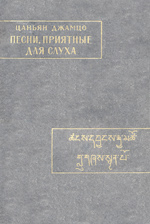|
|
| |

|

|
Tshangs-dbyangs-rgya-mtsho. Dolcet Songs [Цаньян Джамцо. Песни, приятные для слуха]. Fascimile edition of the xylograph and manuscript, critical text, translation from Tibetan and notes by L.S.Savitsky. Moscow 1983. (Pamyatniki pismennosti Vostoka, LXXI).
Summary
The book Dulcet Songs, by Tsangyang Jamtso, is comprised of the following parts.
Introduction. Tibetan literature as a whole is a typical product of the Middle Ages: after the 10th century it developed a religious-didactic pattern both in its content and in its objectives. Tibetan authors undoubtedly exhibited an interest in man. However, they ignored his inner life, emotional experience and relationship with nature. The basic themes of Tibetan literature were «good» and «evil» deeds, which were believed either to bring man nearer to, or to remove him further from, «salvation» or the «attainment of Nirvana», i. e., its main objective was to establish Buddhist norms, in other words ideal standards of behaviour for readers and listeners.
Therefore, it had no place for secular lyrics. Until the 18th century Tibetan lyrical poetry centred around religious feelings and experiences. Tibetan secular lyrics existed exclusively in the form of songs in the sphere of popular oral literature. Presumably, Tibetan love lyrics originated from folklore, more exactly, from domestic ceremonies and songs which individualized and, at the same time, generalized human feelings and emotional experiences. Secular works — also of predominantly folkloric nature — sooner or later had to make their appearance in Tibetan written literature.
Actually, this happened at the beginning of the 18th century, when the short-lived VI Dalai Lama Tsangyang Jamtso created his lyrical poetry.
The chapter VI Dalai Lama Tsangyang Jamtso and the Tibet of the 17th Century and the early 18th Century contains the Tibetan history of the pertinent period and a biography of Tsangyang Jamtso, whose short romantic life and mysterious death on November 14, 1706, which found him on his way to Peking, gave rise to folk legends according to which he magically escaped death at the hands of the Mongols and Chinese and lived for another 40 years dying as late as 1746.
In the chapter Tibetan Poetry of the 7th—17th Centuries is made an attempt to identify the most important methods of Tibetan versification and to trace their evolution in the relevant period. The results of the translator's research support the conclusion of A. Csoma de Korosi (1799—1842) saying that the underlying principle of Tibetan versification is the isosyllabism of lines.
The translator's analysis of Tibetan manuscripts of the 9th-10th centuries discovered in north-eastern Tibet (Tunhuang) and containing pieces of popular oral poetry has shown that ancient Tibetan poetry was dominated by precisely this principle. The system of ancient Tibetan versification also included psychological and rhythmic-syntactic parallelisms. In the translator's opinion, they were extended by phonetic parallelism.
It is noteworthy that the most frequent verse used in'the Tun-huang texts was the six-syllabic metre. For instance, the Tibetan texts of Tun-huang published by F. W. Thomas in 1957 have verse fragments incorporated into prose. The F. W. Thomas text has a total of 721 verses. 315 (43.8 per cent) of these consist of six syllables each and 149 lines have five syllables each whereas 75 of the 721 have seven syllables each. Other metres exhibit a much less frequent occurrence.
The six-syllabic metre occurred even more often in other well-known texts of Tun-huang published by J. Bacot, Ch. Touss-aint and F. W. Thomas. Thus, in ancient popular oral literary works the six-syllabic metre, in addition to being the most frequent, constituted the basic formal marker of popular poetic tradition over the centuries surviving in folklore up to the present time.
Tibetan folk songs include a major group of love songs known as Shay (gzhas). Their characteristic verse form is four lines with six syllables in each. Tsangyang Jamto's poems also reveal this form.
However, the findings of the translator's research are at variance with Korosi's opinion, according to which isosyllabism is the only rhythm-former in Tibetan verses. The poetic parts of ancient Tibetan myths were to a certain extent based on what is known as rhythmic-syntactic parallelism (which includes semantic, morphological and syntactic parallelisms), which occurred in one form or another in all Tibetan poetry, including folklore and Tsangyang Jamtso's poetry. The use of rhythmic-syntactic parallelism led to the emergence in Tibetan versification of repetitions of sounds, including those of syllables or words and similarity or similitude of sounds at the beginning (anaphora) or end (epiphora) of verse lines.
The study of 218 popular songs (gzhas) edited by Professor Namkhai Norbu Dewan has shown that 153 (70 per cent) of these display different types of sound repetition.
 PDF-files PDF-files
Аннотация, Содержание, Предисловие, Summary
Keywords
the Sixth Dalai Lama
Tibetan literature
Tibetan poetry
Tshangs-dbyangs-rgya-mtsho
|
|
|
|
Random news: Announcements |
|
Academic conference in memory of Vsevolod L. Vikhnovich (1937‒2022) will take place on October 29, 2024 (Tuesday) at the IOM RAS (Green Hall). |
|
Read more...
|
|
|
|
|

